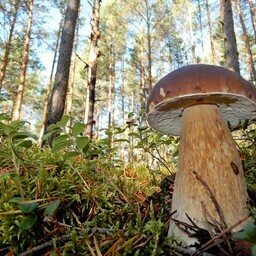Mükoloog Leho Tedersoo ütleb, et see kevad on seenemaailmas eriline. Märtsi lõpus ja aprilli alguses oli sooja. Samuti on kevadel palju vihma sadanud. Need asjad aitavad seentel kasvada. Puud said varakult lehed ja hakkasid
fotosünteesima
. See annab energiat seentele.
fotosünteesima
Tõlge fraasile: fotosünteesima
EN
photosynthesize
Tedersoo on palju metsas käinud. Ta nägi palju kevadisi seeni. Näiteks on praegu kevad-võluheinikute aeg. Neid on sel aastal eriti palju. Ta nägi ka kobarheinikuid, maaheinikuid ja ebaheinikuid. Need seened on tavaliselt septembri lõpus ja oktoobris.
Tedersoo arvab, et
sügisseened
tulevad, kuna temperatuur on muutunud. Kevadel oli sooja, siis jahedam. Niiskust on palju. See tekitab sügisega sarnased tingimused. Seened võivad olla segaduses.
sügisseened
Tõlge fraasile: sügisseened
EN
autumn mushrooms
Enne jaanipäeva võib leida kukeseeni ja puravikke. Tedersoo on näinud ka pilvikuid. Kui otsida, siis kindlasti leiad midagi. Praegu on palju kännumampleid ja muid lagundavaid seeni. Inimesed neid hästi ei tunne.
Tedersoo üllatus kevad-võluheinikute arvust. Neid on palju parkides ja rohumaadel. Tavaliselt on need juuni alguse seened. Tedersoo pole kunagi nii palju neid näinud. Inimesed neid eriti ei korja, sest nad ei tunne neid hästi. Kuid need on maitsvad.
Seeneteadlane Tõnu Ploompuu ütleb, et
seente kasv
ei ole Eestis ühtlane. Võrumaal on seeni palju. Ida-Eestis on seeni rohkem kui Lääne-Eestis. Võrumaal hakkavad
kukeseened
kasvama juba juuni alguses.
seente kasv
Tõlge fraasile: seente kasv
EN
mushroom growth
kukeseened
Tõlge fraasile: kukeseened
EN
chanterelles
Ploompuu on näinud metsades sügisseeni. Ta arvab, et seened tundsid aprillis suve. Siis läks jahedamaks ja tuli niiskust. See on selle aasta eripära. Praegu on näha kasepuravikuid, kukeseeni ja lambatatikke. Liivasemates metsades võivad tulla
pilvikud
.
pilvikud
Tõlge fraasile: pilvikud
EN
russulas
Ploompuu arvab, et Lääne-Eestis tuleb varsti rohkem seeni. Hiljuti jõudis sinna vihm. Võrumaa ja Ida-Eesti sõltuvad sademetest. Liigne vihm võib seentele liiga teha. Seened vajavad
parasjagu vihma
. Praegu võib oodata kukeseeni, tatikuid, pilvikuid ja suviseid puravikke.
parasjagu vihma
Tõlge fraasile: parasjagu vihma
EN
just enough rain
Mycologist Leho Tedersoo says that this spring is special in the mushroom world. It was warm at the end of March and the beginning of April. There has also been a lot of rain this spring. These things help mushrooms grow. The trees got their leaves early and started photosynthesizing. This provides energy to the mushrooms.
Tedersoo has been in the forest a lot. He has seen many spring mushrooms. For example, it is now the time for spring Morels. There are particularly many of them this year. He also saw clustered mushrooms, ground mushrooms, and false mushrooms. These mushrooms usually appear at the end of September and in October.
Tedersoo thinks that autumn mushrooms are coming because the temperature has changed. It was warm in spring, then cooler. There is a lot of moisture. This creates conditions similar to autumn. The mushrooms may be confused.
Before Midsummer, you can find chanterelles and porcini mushrooms. Tedersoo has also seen boletes. If you search, you will definitely find something. There are currently many wood-decaying mushrooms and other decomposing fungi. People do not know them well.
Tedersoo was surprised by the number of spring Morels. There are many of them in parks and meadows. These are usually early June mushrooms. Tedersoo has never seen so many of them. People do not pick them much because they do not know them well. But they are tasty.
Mycologist Tõnu Ploompuu says that mushroom growth is not uniform in Estonia. There are many mushrooms in Võru County. There are more mushrooms in Eastern Estonia than in Western Estonia. In Võru County, chanterelles start growing as early as the beginning of June.
Ploompuu has seen autumn mushrooms in the forests. He thinks that the mushrooms sensed summer in April. Then it got cooler and moisture came. This is a peculiarity of this year. Currently, you can see birch boletes, chanterelles, and hedgehog mushrooms. In more sandy forests, boletes may appear.
Ploompuu thinks that more mushrooms will soon appear in Western Estonia. Rain recently reached there. Võru County and Eastern Estonia depend on precipitation. Excessive rain can harm mushrooms. Mushrooms need the right amount of rain. Currently, one can expect chanterelles, hedgehog mushrooms, boletes, and summer porcini mushrooms.

